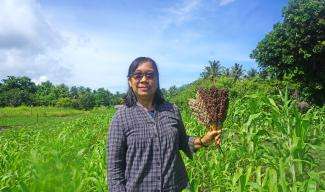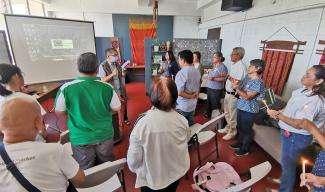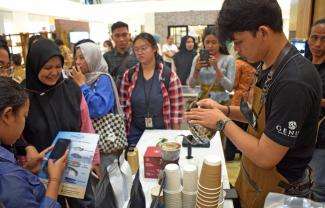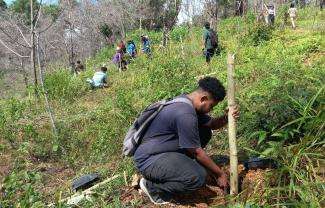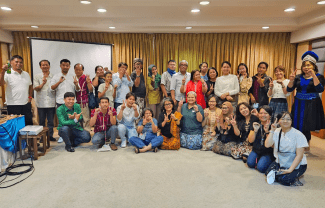Editorial
A long time ago, there was a small village that was suffering from hunger. The only food they had were beans. One day, a young lady named Tonu Wujo, instructed her seven brothers to clear and prepare a field for planting. Then she asked to be slain in the middle of the field. They were not to return to the field after eight days. The youngest brother killed her. After eight days, the brothers came back to see that the field was full of crops. Tonu Wujo’s teeth had become corn. From the drops of her blood and from her flesh, rice had grown. All around were different kinds of vegetables.
This story of how a young girl’s sacrifice became the origin of various crops was passed on from generation to generation among the Lamaholot People in East Nusa Tenggara in Indonesia. And this is the story that inspired Maria Loretha to start relearning their People’s knowledge systems on traditional crops.
The island of East Nusa Tenggara has been suffering El Niño or extreme drought for several decades already. However, a research from the Universitas Indonesia showed that more recent occurrences of the phenomenon recorded even lower rainfall. The trend shows an aggravation of the climate condition, leading to greater problems for the mostly farming-dependent communities on the island. This was what Maria Loretha’s community was facing.
Instead of leaving their territory or encouraging people to give up their traditional occupations, Maria Loretha found the solution in an important crop they had forgotten – the sorghum. The crop is healthier than rice and a small quantity could already feed a number of people. What is more important is that it grows with minimal water needs. For their community that could barely afford to import external food supplies, sorghum would allow them to survive the new extreme weather conditions.
Indigenous communities have generations-old knowledge systems and practices that have allowed them to adapt to changing environmental conditions. Their holistic worldviews provide basis for their practices on sustainability. Nature is their source of daily provisions – food, herbs, household needs, and in today’s market-driven world, also for raw materials for their cottage industries. They live in it, and with it.
Sustainability: One With the Earth’s Natural Movement
“Seeds, if not ‘rotated’ or planted back, will be gone,” explains Pi Mulu, a leader of the Karen People from Northern Thailand, of their farming method. “Life must rotate. People must rotate.”
The tradition of rotational farming is not limited to the Karen People. Indigenous communities across Southeast Asia have been practicing it for generations. Termed as ‘swidden farming,’ it is unfortunately more popularly known for its violent reference – the ‘slash and burn’ technique. The core of the practice is about movement, of allowing land to breathe and recover. And even when the land is being ‘used,’ there is a presence of diversity, different crops are grown, and consequently different animals and insects thrive in the area. It is essentially a sharing of space among different living beings, each dependent and beneficial at the same time to the other lives around it.
Contrary to how it is perceived as destructive, rotational farming is in fact beneficial to the renewal of the environment. It is never stagnant, and there is always harmony between humans and nature. “To rotate is an assurance of continuing what is,” said Pi Mulu.
Commodification of Nature, Land Ownership
However, many indigenous traditions and practices are no longer possible with territorial limitations. With the commodification of nature and the introduction of land ‘ownership,’ community movement has been restricted. And with the limited areas, they are forced to produce higher yield to sustain the needs of their population. In the meantime, vast areas of their territory are used for commercial purposes – logging, monocrop plantations, real estate to name a few . Not only does it disenfranchise the indigenous and local communities, it is also destructive to nature.
In the Philippines, under the Indigenous Peoples’ Rights Act (RA 8371), indigenous communities must apply for a Certificate of Ancestral Domain Title. Although ownership by the community is communal, it is in essence like any kind of land ownership. The ‘owners’ make the decisions over their territory. Thus, it became fuel to various factions and conflicts within the communities. The Dulangan Ancestral Domain in Opol, Misamis Oriental, for example, took several years to secure their title. They had to prove that they had indeed lived in their territory since time immemorial all the while refuting other groups that also claim the same area.
Their struggle was crucial because their elders had envisioned rejuvenating their territory through reforestation and traditional farming methods. A contesting group, however, was interested in its potential for mining.
Often, local government units also take sides in these conflicts. Big investments in the territory would mean an increase in local revenue. They see communities who assert their right to their territories as competition over profits. Instead of educating them of their rights, they are stigmatized as illiterate, incapable of governing their own territories, and even seen as security threats.
Development and Empowerment as Defined by Communities
At this juncture, Indigenous Peoples and Local Communities rightfully ask, what is development? Maybe more importantly, the question of whose development? There is indeed a need for resources to build major industries but how much is needed? Are the communities whose lives are dependent on the environment that is being destroyed benefiting from these industries? And also more importantly, did they choose this kind of development for their community?
It is undeniable that the money economy has long reached the most remote areas of Southeast Asia. Each community is in different levels of market integration. Many communities, while acknowledging the need to earn money, refuse to compromise their sustainable relationship with nature. For them, the land they live on is not just theirs. They owe their children, and future generations a land that is still as productive, still as bountiful as it is for them. Instead of giving up their resources for a one-time payment, they chose to turn to their traditional crafts.
Weaving is a common craft for indigenous women across Southeast Asia. Traditionally used in the day-to-day household activities of the community, weaved products have become attractive in the mainstream market as novelties. The women have taken this opportunity to earn their own living.
In the Huey Eh Khang Village in Thailand, the Che Su Mo weaving group was formed as a livelihood initiative. With weaving, they do not need to convert land use for commercial production. The materials are gathered from the forest, which they, as a community, care and protect. They also improved their use of natural dyes instead of synthetics to encourage their community, especially the younger generation, to understand their relationship with nature. They rely so much on their forest that they make sure it is healthy and will continue to supply the materials they need – bark, leaves, fruits, roots.
The story of Mariana Tuto, an indigenous woman from the East Flores Regency in East Nusa Tenggara, Indonesia, also speaks of this important relationship between women and nature. A victim of domestic violence, she was able to pick up her life after turning to their community’s tradition of weaving to support herself and her son. She founded the Millennial Weaving House in their village, which has become a symbol of women’s empowerment. Mariana passes on her knowledge to the young women in their community, giving them an option to earn in the safety of their community while continuing traditions.
Samdhana’s Lifespace approach
Indigenous Peoples and local communities understand that nature can adapt and heal itself when there are changes in weather patterns. But it can only heal as long as there are no extreme external interventions such as the man-induced fast depletion of natural resources. There is a natural cycle of the earth’s heating and cooling, but it is sped up by aggressive plunder of the environment. Instead of a needs-based use of resources, a consumerist and wasteful culture is prevalent. The use of resources is faster, not allowing for nature to recuperate and heal itself.
Indigenous communities understand that the space is shared even beyond our temporal scope. It is borrowed land and its use should not compromise the enjoyment of future generations.
The Samdhana Institute’s support of the social and environmental movement has always followed and is constantly molding to the evolution of the communities it works with. Samdhana believes that the communities understand best their conditions and have the knowledge systems that could mitigate – or at least address immediate needs while working on bigger and systemic solutions – problems.
From years of learning with the communities, Samdhana understood that a more integrated approach to environmental conservation is needed. It thus institutionalized its Lifespace* approach. It recognizes that first, all living creatures share a common space. Second, a human action or decision will not only affect other human beings but also other living beings in that shared space. And finally, humans have the agency to do something about it.
Environmental conservation is not the total removal of human activities inside natural areas, but control of, understanding and respecting limits of what is necessary and what is excessive. There is a need to understand resource use in a Lifespace. Inhabitants, humans to be specific, have different priorities. But there are shared knowledge systems that are rooted in the enjoyment of this Lifespace.
Admittedly, the market economy has influenced all decision-making processes. These processes have largely been rife with conflict. This is also a matter of control over the territory, over resources.
Just like Tonu Wujo, several indigenous leaders and environmental rights defenders have shed blood to keep their territorial soil fertile and support their community. But Tonu Wujo’s story did not end with her brothers’ benefiting from her death. When she saw that her brothers had become greedy and brought more destruction to their community than good, she left in shame, and gave her grains and bounty to other communities.
‘Mother Earth.’ Perhaps she was Tonu Wujo. The Earth has provided humanity everything we needed. But humanity too became greedy. Tonu Wujo reminds us that resource sharing should be equitable so that a common vision of development is shared and enjoyed by each and every living creature. And Mother Earth continues to thrive.
*the term “Lifespace” evolved from Living Land and Seas that recognizes the integrity and connection from the mountains to the seas, and the social and cultural elements within it; recognizing that these geographical regions should become spaces where life thrives to counter the extractive and destructive activities that threaten it.
